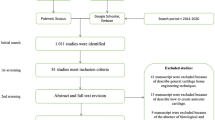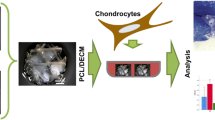Abstract
Background:
In this study, we manufactured a complex of human nasal septal cartilage (hNC) with polycaprolactone (PCL) for transplantation into cartilaginous skeletal defects and evaluated their characteristics.
Methods:
Nasal septum tissue was obtained from five patients aged ≥ 20 years who were undergoing septoplasty. hNCs were isolated and subcultured for three passages in vitro. To formulate the cell–PCL complex, we used type I collagen as an adhesive between chondrocyte and PCL. Immunofluorescence staining, cell viability and growth in the hNC–PCL complex, and mycoplasma contamination were assessed.
Results:
hNCs in PCL showed viability ≥ 70% and remained at these levels for 9 h of incubation at 4 °C. Immunostaining of the hNC–PCL complex also showed high expression levels of chondrocyte-specific protein, COL2A1, SOX9, and aggrecan during 24 h of clinically applicable conditions.
Conclusion:
The hNC–PCL complex may be a valuable therapeutic agent for implantation into injured cartilage tissue, and can be used clinically to repair cartilaginous skeletal defects. From a clinical perspective, it is important to set the short duration of the implantation process to achieve effective functional implantation.








Similar content being viewed by others
References
Nam BM, Kim BY, Jo YH, Lee S, Nemeno JG, Yang W, et al. Effect of cryopreservation and cell passage number on cell preparations destined for autologous chondrocyte transplantation. Transplant Proc. 2014;46:1145–9.
Kim DH, Lim JY, Kim SW, Lee W, Park SH, Kwon M, et al. Characteristics of nasal septal cartilage-derived progenitor cells during prolonged cultivation. Otolaryngol Head Neck Surg. 2018;159:774–82.
Pelttari K, Pippenger B, Mumme M, Feliciano S, Scotti C, Mainil-Varlet P, et al. Adult human neural crest-derived cells for articular cartilage repair. Sci Transl Med. 2014;6:251ra119.
Pelttari K, Mumme M, Barbero A, Martin I. Nasal chondrocytes as a neural crest-derived cell source for regenerative medicine. Curr Opin Biotechnol. 2017;47:1–6.
Candrian C, Vonwil D, Barbero A, Bonacina E, Miot S, Farhadi J, et al. Engineered cartilage generated by nasal chondrocytes is responsive to physical forces resembling joint loading. Arthritis Rheum. 2008;58:197–208.
Rotter N, Bonassar LJ, Tobias G, Lebl M, Roy AK, Vacanti CA. Age dependence of cellular properties of human septal cartilage: implications for tissue engineering. Arch Otolaryngol Head Neck Surg. 2001;127:1248–52.
Ruszymah BHI, Chua KH, Farah WI, Fuzina NH, Aminuddin BS. The expansion potential of human nasal septum chondrocytes for the formation of engineered cartilage. Sci Asia. 2007;33:145–52.
Asghari F, Samiei M, Adibkia K, Akbarzadeh A, Davaran S. Biodegradable and biocompatible polymers for tissue engineering application: a review. Artif Cells Nanomed Biotechnol. 2017;45:185–92.
Hosseinkhani M, Mehrabani D, Karimfar MH, Bakhtiyari S, Manafi A, Shirazi R. Tissue engineered scaffolds in regenerative medicine. World J Plast Surg. 2014;3:3–7.
Park SH, Yun BG, Won JY, Yun WS, Shim JH, Lim MH, et al. New application of three-dimensional printing biomaterial in nasal reconstruction. Laryngoscope. 2017;127:1036–43.
Kim DH, Yun WS, Shim JH, Park KH, Choi D, Park MI et al. Clinical application of 3-dimensional printing technology for patients with nasal septal deformities: a multicenter study. JAMA Otolaryngol Head Neck Surg. 2018;144:1145–52.
Garcia-Giralt N, Izquierdo R, Nogués X, Perez-Olmedilla M, Benito P, Gómez-Ribelles JL, et al. A porous PCL scaffold promotes the human chondrocytes redifferentiation and hyaline-specific extracellular matrix protein synthesis. J Biomed Mater Res A. 2008;85:1082–9.
Park JS, Woo DG, Sun BK, Chung HM, Im SJ, Choi YM, et al. In vitro and in vivo test of PEG/PCL-based hydrogel scaffold for cell delivery application. J Control Release. 2007;124:51–9.
Jung Y, Kim SH, You HJ, Kim SH, Kim YH, Min BG. Application of an elastic biodegradable poly(l-lactide-co-epsilon-caprolactone) scaffold for cartilage tissue regeneration. J Biomater Sci Polym Ed. 2008;19:1073–85.
Martinez-Diaz S, Garcia-Giralt N, Lebourg M, Gómez-Tejedor JA, Vila G, Caceres E, et al. In vivo evaluation of 3-dimensional polycaprolactone scaffolds for cartilage repair in rabbits. Am J Sports Med. 2010;38:509–19.
Munir N, Callanan A. Novel phase separated polycaprolactone/collagen scaffolds for cartilage tissue engineering. Biomed Mater. 2018;13:051001.
Shim JH, Kim JY, Park M, Park J, Cho DW. Development of a hybrid scaffold with synthetic biomaterials and hydrogel using solid freeform fabrication technology. Biofabrication. 2011;3:034102.
Kim DH, Lim JY, Kim SW, Lee W, Park SH, Kwon MY, et al. Characteristics of nasal septal cartilage-derived progenitor cells during prolonged cultivation. Otolaryngol Head Neck Surg. 2018;159:774–82.
Campbell DD, Pei M. Surface markers for chondrogenic determination: a highlight of synovium-derived stem cells. Cells. 2012;1:1107–20.
Riegger J, Palm HG, Brenner RE. The functional role of chondrogenic stem/progenitor cells: novel evidence for immunomodulatory properties and regenerative potential after cartilage injury. Eur Cell Mater. 2018;36:110–27.
Zhou G, Jiang H, Yin Z, Liu Y, Zhang Q, Zhang C, et al. In vitro regeneration of patient-specific ear-shaped cartilage and its first clinical application for auricular reconstruction. EBioMedicine. 2018;28:287–302.
Tohyama H, Yasuda K, Minami A, Majima T, Iwasaki N, Muneta T, et al. Atelocollagen-associated autologous chondrocyte implantation for the repair of chondral defects of the knee: a prospective multicenter clinical trial in Japan. J Orthop Sci. 2009;14:579–88.
Kon E, Filardo G, Di Matteo B, Perdisa F, Marcacci M. Matrix assisted autologous chondrocyte transplantation for cartilage treatment: a systematic review. Bone Joint Res. 2013;2:18–25.
Kafienah W, Jakob M, Démarteau O, Frazer A, Barker MD, Martin I, et al. Three-dimensional tissue engineering of hyaline cartilage: comparison of adult nasal and articular chondrocytes. Tissue Eng. 2002;8:817–26.
Rotter N, Bonassar LJ, Tobias G, Lebl M, Roy AK, Vacanti CA. Age dependence of biochemical and biomechanical properties of tissue-engineered human septal cartilage. Biomaterials. 2002;23:3087–94.
Shafiee A, Kabiri M, Langroudi L, Soleimani M, Ai J. Evaluation and comparison of the in vitro characteristics and chondrogenic capacity of four adult stem/progenitor cells for cartilage cell-based repair. J Biomed Mater Res A. 2016;104:600–10.
Shafiee A, Kabiri M, Ahmadbeigi N, Yazdani SO, Mojtahed M, Amanpour S, et al. Nasal septum-derived multipotent progenitors: a potent source for stem cell-based regenerative medicine. Stem Cells Dev. 2011;20:2077–91.
Swamynathan P, Venugopal P, Kannan S, Thej C, Kolkundar U, Bhagwat S, et al. Are serum-free and xeno-free culture conditions ideal for large scale clinical grade expansion of Wharton’s jelly derived mesenchymal stem cells? A comparative study. Stem Cell Res Ther. 2014;5:88.
Chase LG, Lakshmipathy U, Solchaga LA, Rao MS, Vemuri MC. A novel serum-free medium for the expansion of human mesenchymal stem cells. Stem Cell Res Ther. 2010;1:8.
Bolli R, Chugh AR, D’Amario D, Loughran JH, Stoddard MF, Ikram S, et al. Cardiac stem cells in patients with ischaemic cardiomyopathy (SCIPIO): initial results of a randomised phase 1 trial. Lancet. 2011;378:1847–57.
de Lima M, McMannis J, Gee A, Komanduri K, Couriel D, Andersson BS, et al. Transplantation of ex vivo expanded cord blood cells using the copper chelator tetraethylenepentamine: a phase I/II clinical trial. Bone Marrow Transplant. 2008;41:771–8.
Mohyeddin-Bonab M, Mohamad-Hassani MR, Alimoghaddam K, Sanatkar M, Gasemi M, Mirkhani H, et al. Autologous in vitro expanded mesenchymal stem cell therapy for human old myocardial infarction. Arch Iran Med. 2007;10:467–73.
Karussis D, Karageorgiou C, Vaknin-Dembinsky A, Gowda-Kurkalli B, Gomori JM, Kassis I, et al. Safety and immunological effects of mesenchymal stem cell transplantation in patients with multiple sclerosis and amyotrophic lateral sclerosis. Arch Neurol. 2010;67:1187–94.
Wakitani S, Kimura T, Hirooka A, Ochi T, Yoneda M, Yasui N, et al. Repair of rabbit articular surfaces with allograft chondrocytes embedded in collagen gel. J Bone Joint Surg Br. 1989;71:74–80.
Uchio Y, Ochi M, Matsusaki M, Kurioka H, Katsube K. Human chondrocyte proliferation and matrix synthesis cultured in Atelocollagen gel. J Biomed Mater Res. 2000;50:138–43.
Wongin S, Waikakul S, Chotiyarnwong P, Siriwatwechakul W, Kino-Oka M, Kim MH, et al. Maintenance of human chondrogenic phenotype on a dendrimer-immobilized surface for an application of cell sheet engineering. BMC Biotechnol. 2018;18:14.
Tallheden T, van der Lee J, Brantsing C, Månsson JE, Sjögren-Jansson E, Lindahl A. Human serum for culture of articular chondrocytes. Cell Transplant. 2005;14:469–79.
Technau A, Froelich K, Hagen R, Kleinsasser N. Adipose tissue-derived stem cells show both immunogenic and immunosuppressive properties after chondrogenic differentiation. Cytotherapy. 2011;13:310–7.
Hwang SH, Kim SY, Park SH, Choi MY, Kang HW, Seol YJ, et al. Human inferior turbinate: an alternative tissue source of multipotent mesenchymal stromal cells. Otolaryngol Head Neck Surg. 2012;147:568–74.
Getgood A, Bollen S. What tissue bankers should know about the use of allograft tendons and cartilage in orthopaedics. Cell Tissue Bank. 2010;11:87–97.
Acknowledgements
This research was supported by a grant (18172MFDS185) from Ministry of Food and Drug Safety of Korea 2019. This work was supported by the Korea Health Industry Development Institute funded by the Ministry of Health and Welfare (HI14C3228, HI14C0113), by the Basic Science Research Program through the National Research Foundation of Korea (NRF) grant funded by the Ministry of Education (2017R1D1A1B03027903, 2018R1D1A1B07045421), and by the Bio & Medical Technology Development Program of the National Research Foundation (NRF) funded by the Ministry of Science & ICT (2018M3A9E8020856). This work was also supported by the Institute of Clinical Medicine Research of Bucheon St. Mary’s Hospital, Research Fund, 2018. The sponsors had no role in study design, data collection and analysis, decision to publish, or preparation of the manuscript.
Author information
Authors and Affiliations
Corresponding authors
Ethics declarations
Conflict of interest
The authors indicate no potential conflict of interest.
Ethical statement
All studies utilizing nasal septal chondrocytes were conducted following written approval (HC13TISI0038) from the Institutional Review Board of the Catholic Medical Center Clinical Research Coordinating Center, and after obtaining written informed consent from the donors.
Additional information
Publisher's Note
Springer Nature remains neutral with regard to jurisdictional claims in published maps and institutional affiliations.
Rights and permissions
About this article
Cite this article
Kim, D.H., Lim, M.H., Jeun, J.H. et al. Evaluation of Polycaprolactone-Associated Human Nasal Chondrocytes as a Therapeutic Agent for Cartilage Repair. Tissue Eng Regen Med 16, 605–614 (2019). https://doi.org/10.1007/s13770-019-00210-1
Received:
Revised:
Accepted:
Published:
Issue Date:
DOI: https://doi.org/10.1007/s13770-019-00210-1




